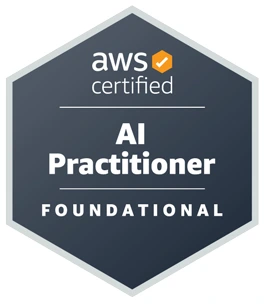ExamPrep CLF-C02 AWS Practi.
Offline or Online AWS: Cloud Practitioner ExamPrep CLF-C02 training.
The AWS Certified Cloud Practitioner (CLF-C02) Exam is a high level introduction to AWS services and is intended to examine the candidates ability to define what the AWS cloud is and the global infrastructure.
It provides overview of AWS core services security aspects, pricing and support services.
Manoj S. Mahajan
28+ years Experienced Trainer with 100+ certs, View full profile....Why join this AWS CLF-C02 ExamPrep training

- Instructor-led training with AWS Certified trainer.
- Hands‑on labs to reinforce theory with practice
- Exam practice questions at the end of each lecture
- Mock exams to prepare for certification success
- Real‑world project simulations for practical experience
Course Description

In this course, you’ll gain an overall understanding of Amazon AWS Cloud, independent of specific technical roles. It provides a detailed overview of cloud concepts, AWS services, security, architecture, pricing, and support.
This course also helps you prepar eand pass the AWS Certified Cloud Practitioner exam.
Audience:
- The AWS Cloud Practitioner is the entry level exam and is intended for people who want to get an idea about the AWS cloud services.
- The AWS Cloud Practitioner Exam is intended for individuals who have knowledge and skills necessary to demonstrate overall understanding of AWS cloud.
- People who want to gain high level overview of AWS.
- Recommended prerequisite: FREE introductory Cloud computing essentials webinar.
Prerequisite:
- Minimum 1+ years IT technical or developer experienceis recommended.
- Basic networking knowledge such as OSI model, TCP/IP model, IP addressing, etc.
- Attend our FREE introductory Networking Essentials webinar.
AWS Certified Cloud Practitioner exam details:
- Exam Code: CLF-C02 - AWS Certified Cloud Practitioner
- Exam Duration: 90 minutes
- Number of Questions: 65 questions, which includes
- Multiple choice: Has one correct response and three incorrect responses (distractors)
- Multiple response: Has two or more correct responses out of five or more response options
- Passing Score: The minimum passing score is 700 out of 1000. Your results for the exam are reported as a scaled score of 100–1000.
- Exam Fee: $100 USD.
- Validity: The certification is valid for three year and can be renewed by passing this same exam.
- Scheduling: The exam can be scheduled and taken at a Pearson VUE test center or through online proctoring.
Syllabus
Please check the syllabus tab above. ☝- Domain 1: Cloud Concepts (24% of scored content)
- Domain 2: Security and Compliance (30% of scored content)
- Domain 3: Cloud Technology and Services (34% of scored content)
- Domain 4: Billing, Pricing, and Support (12% of scored content)
What You'll Learn
Domain 1: Cloud Concepts
- 1.1: Define the benefits of the AWS Cloud.
- Understanding the benefits of global infrastructure (for example, speed of deployment, global reach)
- Understanding the advantages of high availability, elasticity, and agility
- 1.2: Identify design principles of the AWS Cloud.
- Understanding the pillars of the Well-Architected Framework (for example, operational excellence, security, reliability, performance efficiency, cost optimization, sustainability)
- Identifying differences between the pillars of the Well-Architected Framework
- 1.3: Understand the benefits of and strategies for migration to the AWS Cloud.
- Understanding the components of the AWS Cloud Adoption Framework (AWS CAF) (for example, reduced business risk; improved environmental, social, and governance [ESG] performance; increased revenue; increased operational efficiency)
- Identifying appropriate migration strategies (for example, database replication, use of AWS Snowball)
- 1.4: Understand concepts of cloud economics.
- Understanding the role of fixed costs compared with variable costs
- Understanding costs that are associated with on-premises environments
- Understanding the differences between licensing strategies (for example, Bring Your Own License [BYOL] model compared with included licenses)
- Understanding the concept of rightsizing
- Identifying benefits of automation
- Understanding the economies of scale (for example, cost savings)
Domain 2: Security and Compliance
- 2.1: Understand the AWS shared responsibility model.
- Recognizing the components of the AWS shared responsibility model
- Describing the customer’s responsibilities on AWS
- Describing AWS responsibilities
- Describing responsibilities that the customer and AWS share
- Describing how AWS responsibilities and customer responsibilities can shift, depending on the service used (for example, Amazon RDS, AWS Lambda, Amazon EC2)
- 2.2: Understand AWS Cloud security, governance, and compliance concepts.
- Identifying where to find AWS compliance information (for example, AWS Artifact)
- Understanding compliance needs among geographic locations or industries (for example, AWS compliance)
- Describing how customers secure resources on AWS (for example, Amazon Inspector, AWS Security Hub, Amazon GuardDuty, AWS Shield)
- Identifying encryption options (for example, encryption in transit, encryption at rest)
- Recognizing services that aid in governance and compliance (for example, monitoring with Amazon CloudWatch; auditing with AWS CloudTrail, AWS Audit Manager, and AWS Config; reporting with access reports)
- Recognizing compliance requirements that vary among AWS services
- 2.3: Identify AWS access management capabilities.
- Understanding access keys, password policies, and credential storage (for example, AWS Secrets Manager, AWS Systems Manager)
- Identifying authentication methods in AWS (for example, multi-factor authentication [MFA], IAM Identity Center, cross-account IAM roles)
- Defining groups, users, custom policies, and managed policies in compliance with the principle of least privilege
- Identifying tasks that only the account root user can perform
- Understanding which methods can achieve root user protection
- Understanding the types of identity management (for example, federated)
- 2.4: Identify components and resources for security.
- Describing AWS security features and services (for example, AWS WAF, AWS Firewall Manager, AWS Shield, Amazon GuardDuty)
- Understanding that third-party security products are available from AWS Marketplace
- Identifying where AWS security information is available (for example, AWS Knowledge Center, AWS Security Center, AWS Security Blog)
- Understanding the use of AWS services for identifying security issues (for example, AWS Trusted Advisor)
Domain 3: Cloud Technology and Services
- 3.1: Define methods of deploying and operating in the AWS Cloud.
- Deciding between options such as programmatic access (for example, APIs, SDKs, CLI), the AWS Management Console, and infrastructure as code (IaC)
- Evaluating requirements to determine whether to use one-time operations or repeatable processes
- Identifying deployment models (for example, cloud, hybrid, on-premises)
- 3.2: Define the AWS global infrastructure.
- Describing relationships among Regions, Availability Zones, and edge locations
- Describing how to achieve high availability by using multiple Availability Zones
- Recognizing that Availability Zones do not share single points of failure
- Describing when to use multiple Regions (for example, disaster recovery, business continuity, low latency for end users, data sovereignty)
- 3.3: Identify AWS compute services.
- Recognizing the appropriate use of various EC2 instance types (for example, compute optimized, storage optimized)
- Recognizing the appropriate use of various container options (for example, Amazon ECS, Amazon EKS)
- Recognizing the appropriate use of various serverless compute options (for example, AWS Fargate, Lambda)
- Recognizing that auto scaling provides elasticity
- Identifying the purposes of load balancers
- 3.4: Identify AWS database services.
- Deciding when to use EC2 hosted databases or AWS managed databases
- Identifying relational databases (for example, Amazon RDS, Amazon Aurora)
- Identifying NoSQL databases (for example, DynamoDB)
- Identifying memory-based databases (for example, Amazon ElastiCache)
- Identifying database migration tools (for example AWS Database Migration Service [AWS DMS], AWS Schema Conversion Tool [AWS SCT])
- 3.5: Identify AWS network services. Identifying the components of a VPC (for example, subnets, gateways)
- Understanding security in a VPC (for example, network ACLs, security groups, Amazon Inspector)
- Understanding the purpose of Amazon Route 53
- Identifying network connectivity options to AWS (for example AWS VPN, AWS Direct Connect)
- 3.6: Identify AWS storage services.
- Identifying the uses for object storage
- Recognizing the differences in Amazon S3 storage classes
- Identifying block storage solutions (for example, Amazon Elastic Block Store [Amazon EBS], instance store) Identifying file services (for example, Amazon Elastic File System [Amazon EFS], Amazon FSx)
- Identifying cached file systems (for example, AWS Storage Gateway)
- Understanding use cases for lifecycle policies
- Understanding use cases for AWS Backup
- 3.7: Identify AWS artificial intelligence and machine learning (AI/ML) services and analytics services.
- Understanding AI/ML services and the tasks that they accomplish (for example, Amazon SageMaker AI, Amazon Lex, Amazon Kendra)
- Identifying the services for data analytics (for example, Amazon Athena, Amazon Kinesis, AWS Glue, Amazon QuickSight)
- 3.8: Identify services from other in-scope AWS service categories.
- Choosing the appropriate service to deliver messages and to send alerts and notifications
- Choosing the appropriate service to meet business application needs
- Choosing the appropriate option for business support assistance
- Identifying the tools to develop, deploy, and troubleshoot applications
- Identifying the services that can present the output of virtual machines (VMs) on end-user machines
- Identifying the services that can create and deploy frontend and mobile services
- Identifying the services that manage IoT devices
4: Billing, Pricing, and Support
- 4.1: Compare AWS pricing models.
- Identifying when to use various compute purchasing options
- Describing Reserved Instance flexibility
- Describing Reserved Instance behavior in AWS Organizations
- Understanding incoming data transfer costs and outgoing data transfer costs (for example, from one Region to another Region, within the same Region)
- Understanding pricing options for various storage options and tiers
- 4.2: Understand resources for billing, budget, and cost management.
- Understanding the appropriate uses and capabilities of AWS Budgets, and AWS Cost Explorer
- Understanding the appropriate uses and capabilities of AWS Pricing Calculator
- Understanding AWS Organizations consolidated billing and allocation of costs
- Understanding various types of cost allocation tags and their relation to billing reports (for example, AWS Cost and Usage Report)
- 4.3: Identify AWS technical resources and AWS Support options.
- Locating AWS whitepapers, blogs, and documentation on official AWS websites
- Identifying and locating AWS technical resources (for example AWS Prescriptive Guidance, AWS Knowledge Center, AWS re:Post)
- Identifying AWS Support options for AWS customers (for example, customer service and communities, AWS Developer Support, AWS Business Support, AWS Enterprise On-Ramp Support, AWS Enterprise Support)
- Identifying the role of Trusted Advisor, AWS Health Dashboard, and the AWS Health API to help manage and monitor environments for cost optimization
- Identifying the role of the AWS Trust and Safety team to report abuse of AWS resources
- Understanding the role of AWS Partners (for example AWS Marketplace, independent software vendors, system integrators)
- Identifying the benefits of being an AWS Partner (for example, partner training and certification, partner events, partner volume discounts)
- Identifying the key services that AWS Marketplace offers (for example, cost management, governance and entitlement)
- Identifying technical assistance options available at AWS (for example, AWS Professional Services, AWS Solutions Architects)
AWS Certifications & exam registration process
- AWS Certifications
- Exam details
- Exam preparation tips
- Exam registration and scheduling
- Taking the Exam

Rajesh
Training overall is good and the structure of course is designed for entry level candidates. Read more....

Ganesh
It was good experience with trainer and teaching skill good and interact and answering every questions asked by student. Good knowledge and updated with his reliable courses. Read more....

Prashant
It was a really very good experience. All the details covered by sir is really great. Every smallest information was well explained by sir. I am really thankful to sir. Read more....




